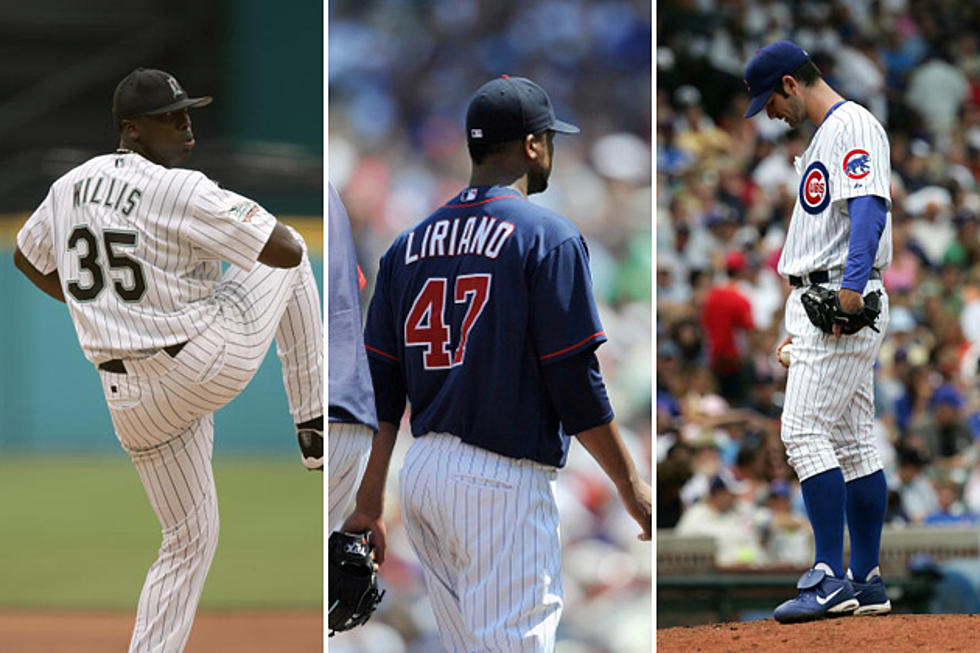
5 Unfortunate Cases Where Pitching Phenoms Flamed Out Early
The Washington Nationals are catching a lot of flak for their decision to shut down ace Stephen Strasburg at the 180-inning mark. Strasburg is hardly the first starting pitcher to encounter injury problems stemming from early overuse, though. General manager Mike Rizzo has held firm on his stance since before the season even started, preferring to preserve the team’s future rather than risk his star’s health on one postseason run.
Here are five examples of prospects who may have been well-served from an innings cap:
Cubs Aces: Mark Prior and Kerry Wood
On top of their other well-documented miseries, Cubs fans were forced to suffer through the same sad story twice. First came Kerry Wood, a young flamethrower who struck out 20 batters in his fifth career start. Wood went on to strike out 233 batters as a rookie, but the major league grind forced him to undergo Tommy John surgery after the breakout ’98 season. He bounced back to post some solid post-operation numbers, but arm troubles routinely hampered his career.
Next was Mark Prior, the team’s best pitching prospect since Wood’s debut. At 22, Prior posted a 2.43 ERA and finished third in the 2003 NL Cy Young voting. Unfortunately, that was the last time Prior would pitch for a full season. The snake-bitten righty has suffered five separate season-ending injuries, and is just another in a long line of “could have beens” for the Chicago Cubs.
Francisco Liriano
Acquired in an infamous trade with the San Francisco Giants, Francisco Liriano seemed destined for greatness. The lefty combined a mid-90s fastball with an array of breaking pitches, drawing comparisons to then-teammate Johan Santana. The phenom justified the hype in 2006, destroying American League batters en route to a 2.16 ERA. Sadly, it only took 16 starts for him to develop elbow pain, and subsequent Tommy John surgery cost him the 2007 season. Liriano has shown flashes of his former potential, but will probably never reach his projected heights.
Dontrelle Willis
In 2003, the ‘D-Train’ exploded onto the National League scene as a 21-year-old. The young lefty exhibited the poise and stuff of a much more seasoned pitcher, earning Rookie of the Year honors and winning 22 games at the age of 23. The Marlins made full use of Dontrelle’s apparent rubber arm, pushing Willis to pitch over 220 innings in back to back seasons. The D-Train was never the same after that effort, posting a career-worst 5.17 ERA at 25 and developing control problems. Now 30, Willis is out of the majors.
Mark Mulder
Billy Beane’s “Moneyball” philosophies may get the publicity for the A’s success in the early 2000s, but the team’s trio of young hurlers deserves the credit. Tim Hudson, Barry Zito, and Mark Mulder formed the core of the American League’s best starting rotation. At 23, Mulder displayed brilliant form, winning 21 games and finishing second in the 2001 AL Cy Young race. Over his first five full seasons, the Michigan State grad averaged a grueling 210 innings. Mulder suffered the first of several shoulder injuries at 28, and made his last MLB appearance in 2008 at the age of 30. He’s now using his arm to help him be a fairly successful golfer.
Generation K
After an absolutely brutal stretch in the early ‘90s, the New York Mets were confident that their organizational struggles were coming to an end. In addition to several high-priced free agents, the 1995 emergence of a trio of talented young hurlers was expected to usher in a new era of playoff success. Dubbed ‘Generation K,’ Bill Pulsipher, Paul Wilson and Jason Isringhausen were all given heavy workloads as rookies. Within a year, each player had suffered a serious arm injury. Of the three, only Jason Isringhausen was able to recover enough to make an All-Star team.
More From 104.5 THE TEAM

![Do We Know The Yankees Identity Yet? [AUDIO]](http://townsquare.media/site/78/files/2015/04/NYY2.jpg?w=980&q=75)







